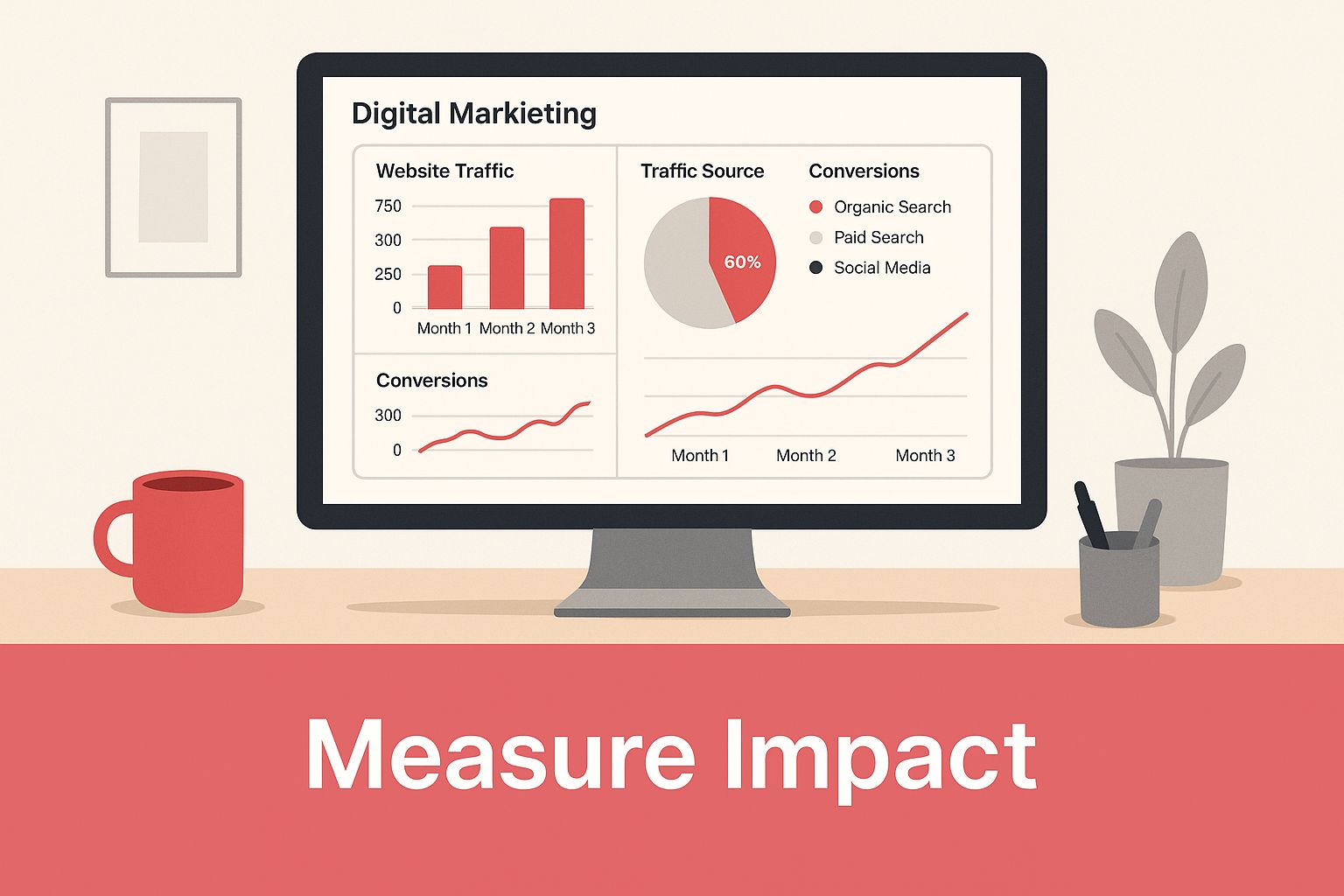 Build Your Ambassador Program for Brands
Build Your Ambassador Program for Brands
"Content marketing attribution" sounds like one of those technical, jargon-heavy terms marketers toss around to sound smart. But really, it’s just about connecting the dots. It’s the simple process of figuring out which pieces of your content—blog posts, webinars, case studies, you name it—actually guided a customer to buy something or take another important action.
It's all about giving credit where credit is due, so you can finally understand what content actually works and why.
Table of Contents
What Is Content Marketing Attribution, Really?
Let's ditch the textbook definition for a moment. Think of your content as a soccer team working together to score a goal.
Your newest blog post might be the midfielder who expertly dribbles the ball down the field. Your in-depth webinar could be the forward who takes a powerful shot. And that persuasive case study? It's the final, gentle tap that guides the ball right into the net.
Content marketing attribution is the instant replay. It shows you exactly how every player—every single piece of content—contributed to that goal. It maps out the journey from someone reading, watching, or downloading your stuff to them becoming a paying customer.
This goes way beyond shallow metrics like page views or social shares. We're talking about tying your content directly to real business impact.
So, Why Does It Matter?
Without a clear way to link content to results, most marketing teams are just guessing. You might be churning out tons of content, but do you have any idea which assets are influencing buyers and which are just collecting digital dust on your server?
Getting a handle on content attribution is a game-changer for a few key reasons:
- Justify Your Budget: When you can walk up to leadership and show that a specific blog series directly influenced a major deal, you’re not talking about "brand awareness" anymore. You're talking about revenue.
- Sharpen Your Strategy: Attribution data tells you what’s hitting the mark. You can confidently double down on the topics and formats that work, while scaling back on the ones that don’t move the needle.
- Prove Your Team's Worth: It gives you the hard evidence to show how your team contributes to the bottom line. This is how you shift the view of content from a "cost center" to a "revenue driver."
There's a growing demand for accountability in marketing, and for good reason. It's no surprise that 54% of marketers are now actively measuring their content marketing ROI. This makes perfect sense when you consider that content marketing typically generates three times more leads and costs 62% less than old-school outbound methods. It's just a smarter, more efficient way to grow. If you're curious about the numbers, you can find a lot more in these content marketing statistics.
At the end of the day, content marketing attribution isn't about getting lost in spreadsheets. It's about finding clarity. It lets you answer the single most important question with confidence: "Is our content strategy actually working?" Armed with that insight, you can make smarter decisions, use your resources wisely, and build a content engine that delivers results you can actually measure.
Getting a handle on content marketing attribution can feel like learning a new sport with a complicated rulebook. Each attribution model is like a different referee, and every single one has its own way of deciding which player—or which piece of content—gets credit for scoring the goal. To pick the right model for your team, you first have to understand how these "referees" make their calls.
Let's walk through the most common models. We'll follow a simple customer journey to see how each one works in the real world.
Customer Journey Example:
Imagine a potential customer, Alex, is looking for a new project management tool. Here's the path she takes before deciding to buy from you:
- Touchpoint 1 (Blog Post): Alex Googles "how to improve team productivity" and lands on your blog post covering the topic.
- Touchpoint 2 (Webinar): A week later, she spots a social media ad for your webinar on "Project Management for Small Teams" and signs up.
- Touchpoint 3 (Case Study): After the webinar, she gets a follow-up email with a link to a case study about a company just like hers.
- Touchpoint 4 (Demo): Impressed by the results, Alex clicks a CTA in the case study, books a product demo, and eventually signs up as a new customer.
Now, let's see how different attribution models would break down Alex's journey.
Single-Touch Attribution Models
These are the most straightforward models out there. They give 100% of the credit for a sale to just one single touchpoint. They're super easy to set up but often paint a far too simple picture of what's usually a complex customer journey.
First-Touch Attribution
This model throws all the credit to the very first interaction a customer has with your brand. It's basically saying the player who first passed the ball is the only one responsible for the goal, completely ignoring everything that happened afterward.
- In Alex's Journey: The blog post, "how to improve team productivity," gets 100% of the credit for the conversion.
- Best For: Companies that are laser-focused on top-of-funnel brand awareness and bringing in new leads. It's great for pinpointing which channels are best at getting your brand in front of new faces.
Last-Touch Attribution
On the flip side, this model gives all the credit to the final interaction right before the conversion. It's the most common model and is often the default setting in many analytics tools. Think of it as crediting only the final shot on goal, ignoring all the assists that made it happen.
- In Alex's Journey: The demo request page, which Alex got to from the case study, receives 100% of the credit.
- Best For: Businesses with really short sales cycles where that final touchpoint is the most powerful nudge, like a lot of e-commerce impulse buys.
Last-touch attribution is popular because it's simple, but it creates a massive blind spot. It consistently undervalues all the top- and mid-funnel content that nurtures leads over time—which is the absolute heart and soul of good content marketing.
This infographic gives a great visual of how a marketing dashboard can be used to measure your content's impact all the way through the funnel.

The real takeaway here is that you can't just look at one metric. Effective measurement means analyzing the entire journey to understand what's truly performing.
Multi-Touch Attribution Models
This is where things get more sophisticated. Multi-touch models spread the credit across several touchpoints, giving you a much more complete and realistic picture of how your content works together to land a conversion.
To make sense of the different multi-touch models, it helps to see them side-by-side. This table breaks down how each one works and where it shines.
Comparing Content Marketing Attribution Models
| Attribution Model | How It Assigns Credit | Best For |
|---|---|---|
| Linear | Spreads credit equally across all touchpoints. | Getting a balanced view of the entire customer journey where every interaction is valued. |
| Time-Decay | Gives more credit to touchpoints closer to the conversion. | Businesses with longer sales cycles (like B2B) where later interactions are more influential. |
| U-Shaped | Gives 40% credit to the first touch, 40% to the last, and splits 20% among the middle touches. | Teams that highly value both the first touch (lead source) and the final touch (conversion driver). |
| First-Touch | Gives 100% credit to the very first interaction. | Brands focused on top-of-funnel marketing and generating new awareness. |
| Last-Touch | Gives 100% credit to the very last interaction. | Companies with short sales cycles and impulse-buy products. |
| W-Shaped | Assigns 30% each to the first touch, lead creation, and last touch, splitting 10% among others. | More advanced marketers who want to credit key mid-funnel milestones. |
As you can see, there's no single "best" model—it all depends on your business goals and what you want to measure. Let's look at the main multi-touch options in more detail.
Linear Attribution
The Linear model is the simplest of the multi-touch crew. It just divides the credit equally among every single touchpoint in the customer's journey. No favorites here.
- In Alex's Journey: The blog post, webinar, case study, and demo page each get a clean 25% of the credit.
- Best For: Marketers who want a balanced scorecard for the whole customer journey and believe every interaction plays an equal part.
Time-Decay Attribution
This model operates on the idea that the closer an interaction is to the sale, the more important it was. It gives more credit to touchpoints that happened nearer to the moment of conversion.
- In Alex's Journey: The demo page would get the biggest slice of credit, followed by the case study, then the webinar, with the initial blog post getting the smallest piece.
- Best For: Companies with longer consideration phases, like B2B SaaS, where late-stage content like a powerful case study or a compelling demo often seals the deal.
U-Shaped (Position-Based) Attribution
The U-Shaped model gives the most weight to what are often seen as the two most critical moments: the first touch (how they found you) and the last touch (what made them convert). It usually gives 40% of the credit to the first interaction, 40% to the last one, and splits the remaining 20% across everything in between.
- In Alex's Journey: The blog post gets 40%, the demo page gets 40%, and the webinar and case study each get 10%.
- Best For: Businesses that place a high value on both generating the lead and closing the deal. It's a great way to recognize the content that starts the conversation and the content that finishes it.
Choosing the right model is a huge step in building a content marketing attribution strategy that actually works. Each one tells a different story about your customer's journey, and the story you choose to listen to will directly shape your understanding of what content is really moving the needle.
Choosing the Right Attribution Model for Your Business

Now that we’ve walked through the different attribution models, it’s time to pick the right one for your game. This isn’t a one-size-fits-all kind of deal. A model that brings perfect clarity to an e-commerce shop could completely muddy the waters for a B2B software company.
Your choice has to be grounded in the reality of your business. To get you from theory to practice, let's zero in on the three factors that really matter when you're making this call.
Analyze Your Sales Cycle Length
How long does it take for someone to go from "who's this?" to pulling out their credit card? This is probably the most critical piece of the puzzle. Is it an impulse buy that takes a few minutes or a major decision that stretches out over months?
Short Sales Cycles (e.g., Ecommerce, DTC): For businesses where customers make up their minds fast, you can keep it simple. A Last-Touch model often gets the job done because that final nudge—clicking a promo email or an ad for that one specific product—is genuinely the most powerful push. The journey is short and sweet, so that last action holds a lot of weight.
Long Sales Cycles (e.g., B2B, High-Ticket Items): When a sale takes weeks or months to close, a Last-Touch model becomes dangerously misleading. It totally ignores all the blog posts, webinars, and case studies that built trust and answered questions along the way. In this scenario, a Time-Decay or Linear model gives you a much more honest picture by recognizing all the hard work your content did over time.
Evaluate Your Customer Journey Complexity
Next up, think about the path a typical customer takes. Is it a straight shot from A to B, or more of a winding road with plenty of detours?
A simple customer journey might only have two or three touchpoints—say, a social media ad, a click to a product page, and then a purchase. On the other hand, a complex journey could involve dozens of interactions across your blog, YouTube channel, webinars, and social media profiles before a decision is ever made.
The more twists and turns in the journey, the more you need a multi-touch attribution model. Trying to understand a complex journey with a single-touch model is like trying to review a movie after only watching the final scene.
For those more intricate paths, U-Shaped or W-Shaped models are incredibly valuable. They give proper credit to the big moments—that first discovery and the point a prospect becomes a real lead—which are often the most important turning points in a long buying process.
Align with Your Core Business Objectives
Finally, what are you actually trying to accomplish right now? Your main goal should be the north star for your attribution choice. A model is just a tool, so you need to grab the right one for the job at hand.
Are you trying to pack the top of your funnel with brand new leads, or are you focused on perfecting the final steps that seal the deal?
Goal Is Awareness and Reach: If your number one priority is getting your brand in front of fresh eyes, the First-Touch model is your best friend. It shines a bright light on the content and channels that kickstart the entire customer relationship. A big part of this is understanding how your content's reach is even measured in the first place. You can learn more about how is reach calculated to get a better handle on your brand's true visibility.
Goal Is Driving Conversions: If you're laser-focused on closing sales, then a Last-Touch or U-Shaped model will likely serve you better. These models put the emphasis on the content that comes right before a purchase, showing you exactly what’s pushing customers across the finish line.
At the end of the day, the best content marketing attribution model is the one that gives you actionable clarity for your business. By thinking through your sales cycle, customer journey, and key goals, you can pick a model that helps you turn messy data into smarter marketing decisions.
How to Put Your Attribution Strategy Into Action

Moving from theory to practice can feel like a huge leap, but rolling out a content marketing attribution strategy is really more about the process than it is about perfection. It’s a series of totally manageable steps that, once you put them together, bring some serious clarity to your marketing. You don't need an army of data scientists—just a clear plan.
Let’s break down exactly how to build your attribution framework from the ground up. We'll focus on concrete steps you can start taking today. The goal here is to create a system that turns all that abstract data into a reliable guide for your content decisions.
First, Define Your Conversion Goals
Before you can track anything, you have to decide what a "win" actually looks for your content. And spoiler alert: a conversion isn't always a final sale. There are meaningful goals all along the customer journey, from the first hello to the final handshake.
Think of these as milestones on a road trip. Each one tells you a prospect is heading in the right direction. Naturally, your goals should line up with the different stages of the buyer's journey.
- Top-of-Funnel Goals: Here, you're all about education and engagement. A conversion could be a newsletter signup, a new social media follow, or someone downloading a simple checklist.
- Middle-of-Funnel Goals: At this point, people are actively looking for solutions. Key conversions include registering for a webinar, downloading a deep-dive ebook, or kicking off a free trial.
- Bottom-of-Funnel Goals: This is where prospects are ready to make a choice. The big conversions are things like booking a demo, requesting a quote, or, of course, making a purchase.
By defining these distinct goals, you can measure how well each piece of content is doing its specific job, whether that's grabbing new eyeballs or closing the deal.
Master the Basics of Tracking
With your goals locked in, the next step is getting the technical foundation right so you can track them accurately. This is where a lot of marketers get nervous, but the core tools are more accessible than you'd think. Your two best friends here are analytics platforms and UTM parameters.
1. Get Your Analytics Platform Set Up
Tools like Google Analytics are basically the command center for your attribution work. This is where you’ll configure the conversion goals you just defined. For instance, you can set up a goal that fires every single time a user lands on your "thanks for requesting a demo!" page.
2. Standardize Your UTM Parameters
UTM parameters are just simple tags you add to the end of a URL. They tell your analytics tool exactly where a visitor came from. A consistent, standardized UTM strategy is absolutely non-negotiable if you want clean attribution data.
A messy approach to UTMs is like trying to sort a mountain of mail with no addresses on the envelopes. It creates total chaos in your data, making it impossible to tell which campaigns or blog posts are actually driving traffic and conversions.
Centralize Your Data
Your customer data is probably scattered across a few different places. A prospect might read a blog post (tracked in Google Analytics), then sign up for a webinar (tracked in your email platform), and finally get logged in your CRM by a sales rep. To see the whole story, you have to bring these pieces together.
This is where integrating your key platforms is a game-changer. By connecting your CRM (like HubSpot or Salesforce) with your analytics tools, you can link the content someone engaged with before converting to the sales data that comes after. That connection is what lets you prove a blog post read in January led to a deal closed in March.
This integration creates a single source of truth, showing you how content influences the entire pipeline, not just the first click. It’s also crucial to track content from everywhere, including what your creator partners are making. Knowing how to create UGC content is step one, but tracking its impact is what proves its real value.
Commit to Data Hygiene
Finally, you have to accept that attribution isn't a "set it and forget it" kind of task. It demands an ongoing commitment to data hygiene—keeping your tracking clean, consistent, and accurate. Messy data only leads to bad insights and worse decisions.
- Audit Your Tracking Regularly: Hop in and make sure your conversion goals are still firing correctly.
- Enforce UTM Discipline: Create a shared document for your team that outlines your UTM naming rules. This ensures everyone is tagging links the same way.
- Clean Your CRM Data: Every so often, go through and remove duplicate contacts or standardize data entry formats.
When you build a solid foundation with clear goals, consistent tracking, and clean data, you create a trustworthy system for content marketing attribution. It’s this system that will empower you to make smarter, revenue-focused decisions with your content.
Turning Attribution Data Into Smarter Decisions
Collecting attribution data is a bit like gathering ingredients for a big meal. Having all the right stuff is great, but the real magic happens when you actually start cooking. The whole point of content marketing attribution isn’t just to look back at what happened; it’s to actively shape your next move and make smarter, data-backed decisions.
This means you have to move past the simple, surface-level metrics. It’s the difference between knowing a blog post got 10,000 views and knowing it directly influenced three major sales deals. One is a nice-to-have stat; the other is a rock-solid business case. The goal is to create a feedback loop—test, learn, and optimize—that constantly sharpens your content’s impact and proves its worth.
Blend Quantitative and Qualitative Insights
Your attribution reports tell you the "what"—which articles, videos, or webinars played a role in a conversion. But to really get to the "why," you need to mix that hard data with some human feedback. Numbers on their own just don't paint the full picture.
To get a complete view, try pairing your attribution reports with direct insights from your customers and sales team. This can be as simple as:
- Combing through sales call notes: What questions are prospects actually asking? Your content should be the answer.
- Surveying new customers: A quick "What content helped you the most?" can uncover hidden gems in your funnel.
- Analyzing support tickets: Look for common problems or frustrations that could be solved with a new tutorial or guide.
When you combine the data with real human stories, you get a much clearer, three-dimensional view of what’s working. This helps you create content that not only looks good on a report but genuinely connects with your audience.
Use Performance Data to Guide Your Content Calendar
One of the most practical ways to use attribution is to let it tell you what to create—or update—next. Your data is essentially a roadmap showing you exactly where to invest your time and budget for the biggest payoff.
Think about it: marketers who refresh old content see a 53% average increase in engagement. And 83% of marketers say creating higher-quality content less often is more effective than just churning out tons of mediocre stuff. This is where attribution becomes your best friend, helping you pinpoint your top performers so you can double down on what works.
Attribution insights help you answer critical strategic questions like:
- Which topics are consistently driving high-value leads? Maybe it's time to build a pillar page around that theme.
- What formats—webinars, case studies, checklists—are killing it at the bottom of the funnel? Let's make more of those.
- Which older blog posts get traffic but don't convert? Let's give them a facelift with stronger calls-to-action.
At the end of the day, content attribution is all about improving your return on investment. If you're looking for more ways to demonstrate value, you can find some great strategies for measuring social media ROI.
This data-first approach transforms your content calendar from a shot in the dark to a strategic plan built on proven results. It's especially crucial when working with partners, since you can more accurately measure influencer marketing ROI when you know which content actually drives action. By building a culture that values data, you empower your team to focus on making a real impact, not just hitting publishing quotas.
Common Questions About Content Attribution
As you start putting all this theory into practice, it's completely normal for a few questions to pop up. Building a solid content attribution framework is a journey, not a destination. Tackling these common hurdles head-on is the best way to get comfortable.
Let's clear up some of the most frequent questions marketers have when they're getting started.
What Is the Difference Between Marketing and Content Attribution?
The easiest way to think about it is like a wide-angle lens versus a zoom lens.
Marketing attribution is the wide-angle view. It looks at everything you're doing to market your business—paid search, social media ads, email blasts, you name it. Its job is to figure out how all those different channels work together to land a conversion, spreading the credit across your entire marketing mix.
Content marketing attribution, on the other hand, zooms in. It specifically focuses on the role your organic content plays in that journey. We're talking about the blog posts, case studies, videos, and ebooks your team sweats over. It’s all about isolating and proving the value of those specific assets.
How Can Small Businesses Start Without Expensive Tools?
You absolutely do not need a huge budget to get your feet wet with attribution. The real secret is to start with what you've got and just be consistent.
Google Analytics is an incredibly powerful and free tool that can be the bedrock of your entire strategy. If you set up conversion goals and get disciplined about using UTM parameters, you can immediately start seeing which blog posts are driving traffic to your money pages or which ebooks are generating leads.
This kind of simple, no-cost setup gives you actionable insights right away. It proves that good attribution is more about having a smart process than having pricey software.
How Often Should I Review My Attribution Reports?
There's no one-size-fits-all answer here—it really depends on how long your sales cycle is.
- Short Sales Cycles: If you're in e-commerce or DTC where customers decide in days or even hours, you'll want to check your reports weekly or bi-weekly. This helps you spot trends and react fast.
- Long Sales Cycles: For B2B folks with sales cycles that drag on for months, a monthly or quarterly review makes more sense. It gives you a much more strategic, big-picture view of what’s working.
The most important part is to get into a regular rhythm. Consistency is what turns data collection into a powerful tool for refining your strategy. It also helps to go in with realistic expectations by understanding the common challenges of data-driven attribution before they crop up.
Ready to amplify your brand's voice and see real results from your content? JoinBrands connects you with over 250,000 creators to produce authentic UGC and manage high-impact campaigns seamlessly. Start your creator marketing journey with JoinBrands today!








